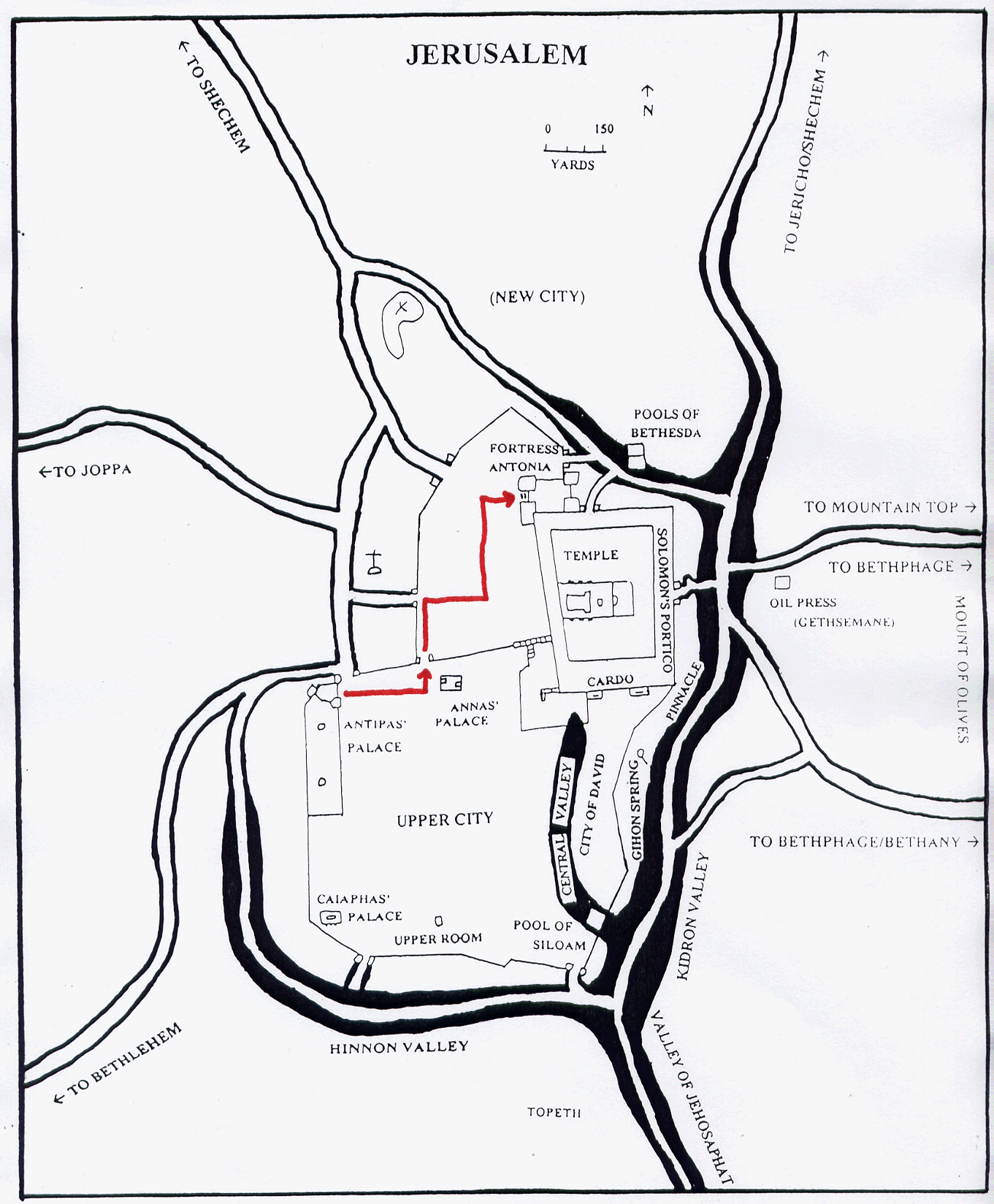82 – Second Trail Before Pilate
Where: Antonia Fortress, Jerusalem, Judea
Scripture:
Notes:
Listen to audio
Antipas had returned Jesus to Pilate. ‘Thank you for allowing me to question Jesus’, noted Antipas, ‘but I do not believe that Jesus has any political ambitions’. At the Fortress of Antonia, Pilate met again with the religious leaders and a small crowd of people, the majority of which were supporters of the leaders and had been gathered by them.
Pilate had given the matter some thought. One question kept coming to mind. ‘Why are the religious leaders so afraid of Jesus?’ Then Pilate devised a test. Do they fear Jesus more than they fear the Romans?
Pilate would give the leaders a choice. Pilate would set one prisoner free. Would they choose Barabbas, a known terrorist [or freedom fighter], and thereby antagonize Rome and betray their own God? Or would they choose Jesus of Nazareth, a religious teacher, and have peace with Rome and show loyalty to their God?
Pilate took Jesus and Barabbas out to face the leaders and the crowd, and said to them, ‘Jesus offers you peace. Barabbas offers you war. Which shall I set free?’
To the religious leaders the choice was simple: Jesus must die! Barabbas could never win the hearts of the people and lead the nation against Rome. Jesus could win many, but must ultimately fail. And all the power of Rome would fall upon Israel and they would lose their religious freedoms. Jesus was the greater threat. The leaders had NO choice left. They stirred up the crowd to demand that Barabbas be freed [then they could blame the choice on “the people”].
The choice had been made. Now Pilate needed to decide what to do with Jesus. ‘What threat did the religious leaders perceive, such that they were willing to betray one of their own and antagonize the Romans?’
So Pilate brought Jesus back inside and questioned him some more. Pilate wanted to set Jesus free in order to antagonize the religious leaders that had already damaged their credibility with their own people. If only Jesus would provide Pilate with some excuse. It was at this time that Pilate received a message from his wife. She had a dream that Jesus was innocent and that Pilate needed to get out of the situation.
But Pilate was just a tool and Jesus had no intention of letting Pilate stand in the way of the choice that the religious leaders had made. Just as it was necessary that someone hand Jesus over to the religious leaders in order to force their decision, so it was necessary that someone carry out the death sentence.
Pilate brought Jesus before the leaders and those that they had gathered. But this time he was going to push the religious leaders. ‘I find no crime against Rome that warrants death’, Pilate said.
But the religious leaders were ready with their final argument. ‘He says that he is a king’, they argued. ‘What would Caesar do to you if you allowed a rival of Caesar’s to live?’
Pilate felt fear! Caesar would have Pilate killed (or worse). The implied threat angered Pilate. ‘You threatened my power’, he thought, ‘then I will threaten your power’. Pilate decided to set the religious leaders against their people. Pilate asked, ‘what should I do with YOUR king?’
‘We have no king but Caesar’, someone shouted in the heat of the moment, to be sure that Pilate would condemn Jesus to death, though Israel claimed they had no king but God.
When Pilate asked what he should do with Jesus, in a moment of religious passion, some there started shouting, ‘crucify him’. That was not what Caiaphas would have preferred, but the majority got carried away with religious fervor and there would be no stopping them now.
Now the people would know that their religious leaders had arranged for an innocent man to be killed by foreigners. Just as David had done when he had foreigners kill Uriah. That act of injustice had angered God then and would surely anger God now.
Now Pilate chose to “twist the knife”. He had a basin of water brought out and he announced that he would allow Jesus to be crucified, but that he “washed his hands” of the responsibility for the spilling of the innocent blood of Jesus just as elders in Israel had done in the past. As he was washing his hands someone in the crowd yelled out that they would accept the responsibility for the death of Jesus.
At around 8 am, Pilate turned Jesus over to his soldiers to be executed, NOW!
Jesus would be treated just as hundreds of other leaders that opposed Roman rule had been treated. He was a rebel and he would suffer. The guards took him into the courtyard, where Jesus was stripped. He was tied to a post and whipped, with a short whip with metal tipped thongs, until he was bloodied and weak. The flesh hung in strips down his back, from his shoulders to his knees. But before he could pass out, they stopped. The guards were now free to “play” with this “so called” king.
They gave Jesus a crown, like Caesar’s wreath crown (only this one had short thorns) from twigs taken from the fireplace. The thorns were pressed onto the head of Jesus.
They gave Jesus a scarlet robe, like Caesar’s royal purple robe.
They even gave Jesus a symbol of authority, a scepter (a stick that was lying nearby), like Caesar’s scepter. Then the guards pretended that Jesus was a king and bowed to him, and then hit Jesus with the scepter and spit on him. ‘Greetings, king of the Jews’, they spat.
As they put Jesus on display in front of the people who were gathered outside, they said, ‘Behold the man who would be your king’. Sadism was not uncommon under these circumstances and was prophesied by Isaiah.
Then the guards took Jesus back inside and made him get dressed in his own clothes. But they left the crown on, to remind everyone that Jesus is their king, and they prepared for the procession thorough Jerusalem, to the place of execution. Now the Judean Jews could spend their time in preparation for the Judean Passover.
DAB
No questions have been asked yet.

